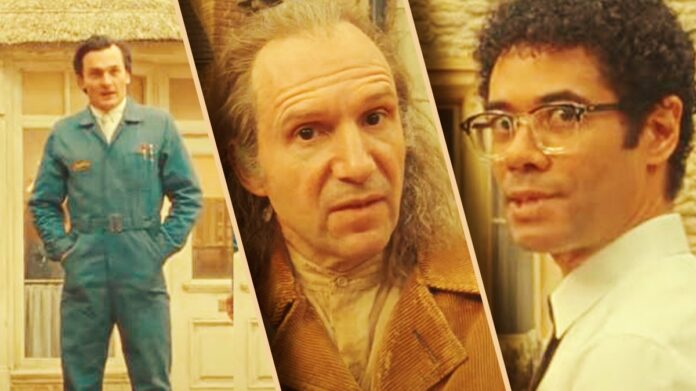Wes Anderson’s Roald Dahl short story adaptations continue to grace us, and the third one is The Rat Catcher. This film is twisted, and Wes uses some brilliant lighting and zoom techniques to really bring out the horrifying nature of this story. Of course, all the actors are marvelous, and although this story is quite slow at the beginning, it quickly picks up pace in the third act with a remarkable twist. This is horror in Wes’s style. A sinister tale with a dark twist. The story comes from Dalh’s collection, Claud’s Dog. The Rat Catcher is brought to life through the narration of Richard Ayodae and is acted out by Ralph Fiennes and Rupert Friend. Ayodae is the realistic driving force of this story as he pushes us to see the more ethical side of thnigs.
Spoilers Ahead
What Happens in the Film?
Claud is desperate to get rid of the rats in the village and has called upon the Rat Man to come save the day. The Rat Man arrives one afternoon with a gait and teeth like rats. There’s something very rat-like about the man himself, which is unsettling to Claud and our narrator. The Rat Man, of course, is looking to make a scene out of this situation and show these two men that he’s better and smarter than them. He asks if the job is a sewer job, and Claud says it’s not. The Rat Man goes on to explain how he’d kill rats in the sewer. According to him, if one is to catch rats, they must be smarter than rats. The Rat Man is not just physically like rats; he believes he’s as smart as them, too. He doesn’t capture rats, but rather kills them. He asks if the village is plagued by some sort of sickness because of the rats and sounds disappointed to find out that it isn’t.
With his dirty fingers, the Rat Man showed the men a tin that he carried around, filled with poison. He claims there’s enough poison in there to kill a million men. It’s a tin of oats soaked in deadly poison that would kill the rats instantly. According to the clever Rat Man, rats could never resist oats. Somehow, though, over four days, the poisoned oats didn’t work. The Rat Man then placed the oats in piles rather than scattering them as he had done before. This is when he realizes that there’s something fishy going on in this village. The rat man thinks somebody is secretly feeding these rats, and that’s why they would never come close to the oats. With his reputation in the pits, the Rat Man needed to show off some machismo to make Claud and the poor narrator admire him again.
He brings out a live rat from his pocket and shows it to the men. Then he takes out a ferret from another pocket. One who obeys the rat man. Taking off his jacket, he places the two rodents inside his shirt. As Claud and the narrator watch on in desperation, the ferret chases the rat inside the shirt, and all of a sudden everything stops. The Rat Man pulls out the ferret unharmed, but the rat is dead. Of course, Claud was disturbed by this view and told the Rat Man that he would be in trouble one of these days if he got nipped by one of the animals. Unbothered, the Rat Man felt he was regaining his strength and reputation and decided to show them another trick.
The Rat Man brings out another live rat and tells the men that if they bet, he will kill the rat without removing his hands from his pockets. Intrigued, Claud gives in and bets a shilling. On the other hand, the narrator has no choice but to watch, petrified, with his feet stuck to the ground. The Rat Man builds the tension by inching his face closer and closer to the rat until they’re too close. As the narrator watches on, the Rat Man opens his mouth wide—too wide—and then the narrator looks away. We don’t know exactly what the Rat Man did to the rat, but he spits out some blood from his mouth, indicating that he bit it to death. Seeing the blood, Claud calls the Rat Man disgusting, but he feels no shame. He takes the money and tells the men that the secret is that the rat’s blood is used in licorice, and all the chocolate factories do the same thing. He claims there’s nothing wrong in consuming some rat blood.
Finally, Claud and the narrator show their disgust and anger towards the Rat Man, making him realize that he is no longer wanted there. As he makes his way out of there silently, silently like a rat, we’re left wondering about the rats in the haystack. The narrator finishes off by wondering if the haystack consisted of something nutritious for the rats not to eat the poisoned oats. Listening to the Rat Man’s clever plans didn’t make a difference, and as we empathize with the rats, at least we’re left with the thought that the rats remain unharmed. We see the story from the point of view of the narrator, who finds the rat catcher quite strange, unlike Claud, who seems to have some interest in the man. Interestingly, in the end, the rat catcher doesn’t display cleverness but uses brutality to kill the rat, so his point is quite invalid.
Final thoughts
The Rat Catcher is creepy, and there’s a bleakness to the story. Wes Anderson captures this very well through his lens and style. The scenes where Rupert Friend acts out the rat’s parts are very nicely done and create intrigue for this tale. Although it may not be the best of the short films, it’s definitely enjoyable, especially because of the performances.

